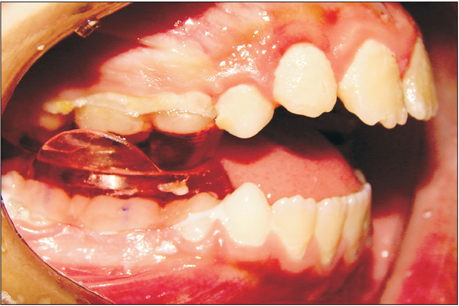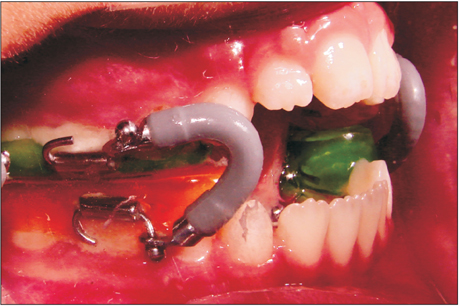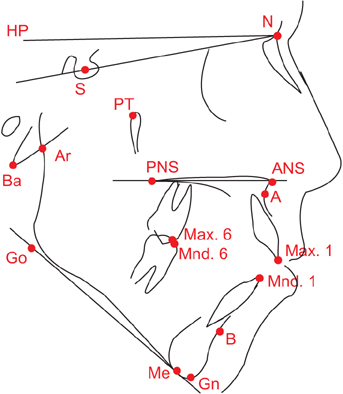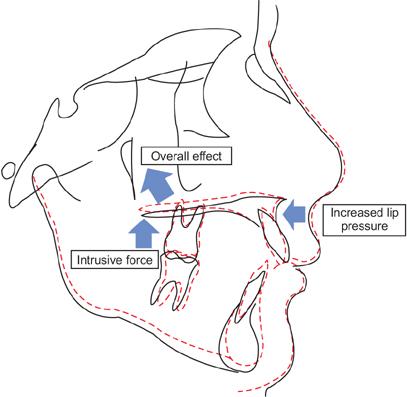Korean J Orthod.
2015 Jan;45(1):38-46. 10.4041/kjod.2015.45.1.38.
Early treatment of anterior open bite: Comparison of the vertical and horizontal morphological changes induced by magnetic bite-blocks and adjusted rapid molar intruders
- Affiliations
-
- 1Department of Orthodontics, Faculty of Dentistry, Damascus University, Damascus, Syria. hassanbuga@hotmail.com
- 2Section of Orthodontics, Graduate School of Dental Science, Kyushu University, Fukuoka, Japan.
- KMID: 2074821
- DOI: http://doi.org/10.4041/kjod.2015.45.1.38
Abstract
OBJECTIVE
This prospective clinical study aims to determine the differences between two treatment modalities for anterior open bite in growing patients. The treatment modalities involved the use of magnetic bite-blocks (MBBs) or rapid molar intruders (RMIs) applied with posterior bite-blocks.
METHODS
Fifteen consecutive patients with a mean age of 11.2 (standard deviation [SD] = 1.6) years and a mean open bite of -3.9 mm were treated with MBBs. Another 15 consecutive patients with a mean age of 10.9 (SD = 1.8) years and a mean open bite of -3.8 mm were treated with RMIs applied on bite-blocks. Cephalometric radiographs were obtained before (T1) and immediately after appliance removal (T2). The treatments lasted four months, during which the appliances were cemented to the teeth. The morphological changes were measured in each group and compared using logistic regression analysis.
RESULTS
The MBB group exhibited significantly greater decreases in SNA angle, ANB angle, overjet, and maxillary incisor angle (p < 0.05). The MBBs induced greater effects on the maxilla and maxillary dentition. The MBBs restrained maxillary forward growth and retracted the maxillary incisors more effectively than did the RMIs. Consequently, changes in the intermaxillary relationships and overjets were more distinct in the MBB group.
CONCLUSIONS
The anteroposterior differences between the appliances suggest that MBBs should be preferred for the treatment of patients with Class II open bites and maxillary incisor protrusions.
MeSH Terms
Figure
Reference
-
1. Cangialosi TJ. Skeletal morphologic features of anterior open bite. Am J Orthod. 1984; 85:28–36.
Article2. Sankey WL, Buschang PH, English J, Owen AH 3rd. Early treatment of vertical skeletal dysplasia: the hyperdivergent phenotype. Am J Orthod Dentofacial Orthop. 2000; 118:317–327.
Article3. English JD. Early treatment of skeletal open bite malocclusions. Am J Orthod Dentofacial Orthop. 2002; 121:563–565.
Article4. Iscan HN, Sarisoy L. Comparison of the effects of passive posterior bite-blocks with different construction bites on the craniofacial and dentoalveolar structures. Am J Orthod Dentofacial Orthop. 1997; 112:171–178.
Article5. Işcan HN, Akkaya S, Koralp E. The effects of the spring-loaded posterior bite-block on the maxillo-facial morphology. Eur J Orthod. 1992; 14:54–60.
Article6. Gurton AU, Akin E, Karacay S. Initial intrusion of the molars in the treatment of anterior open bite malocclusions in growing patients. Angle Orthod. 2004; 74:454–464.7. Dellinger EL, Dellinger EL. Active vertical corrector treatment--long-term follow-up of anterior open bite treated by the intrusion of posterior teeth. Am J Orthod Dentofacial Orthop. 1996; 110:145–154.
Article8. Dellinger EL. A clinical assessment of the Active Vertical Corrector--a nonsurgical alternative for skeletal open bite treatment. Am J Orthod. 1986; 89:428–436.
Article9. Woods MG, Nanda RS. Intrusion of posterior teeth with magnets. An experiment in growing baboons. Angle Orthod. 1988; 58:136–150.10. Melsen B, McNamara JA Jr, Hoenie DC. The effect of bite-blocks with and without repelling magnets studied histomorphometrically in the rhesus monkey (Macaca mulatta). Am J Orthod Dentofacial Orthop. 1995; 108:500–509.
Article11. Meral O, Yüksel S. Skeletal and dental effects during observation and treatment with a magnetic device. Angle Orthod. 2003; 73:716–722.12. Kuster R, Ingervall B. The effect of treatment of skeletal open bite with two types of bite-blocks. Eur J Orthod. 1992; 14:489–499.
Article13. Barbre RE, Sinclair PM. A cephalometric evaluation of anterior openbite correction with the magnetic active vertical corrector. Angle Orthod. 1991; 61:93–102.14. Kiliaridis S, Egermark I, Thilander B. Anterior open bite treatment with magnets. Eur J Orthod. 1990; 12:447–457.
Article15. Kalra V, Burstone CJ, Nanda R. Effects of a fixed magnetic appliance on the dentofacial complex. Am J Orthod Dentofacial Orthop. 1989; 95:467–478.
Article16. Carano A, Machata W, Siciliani G. Noncompliant treatment of skeletal open bite. Am J Orthod Dentofacial Orthop. 2005; 128:781–786.
Article17. Cinsar A, Alagha AR, Akyalçin S. Skeletal open bite correction with rapid molar intruder appliance in growing individuals. Angle Orthod. 2007; 77:632–639.
Article18. Dahlberg G. Statistical methods for medical and biological students. London: George Alien and Unwin Ltd;1940.19. McNamara JA Jr. An orthopedic approach to the treatment of Class III malocclusion in young patients. J Clin Orthod. 1987; 21:598–608.20. Buschang PH, Jacob H, Carrillo R. The morphological characteristics, growth, and etiology of the hyperdivergent phenotype. Semin Orthod. 2013; 19:212–226.
Article21. Bourauel C, Köklü SO, Vardimon AD. Integrated magnetic and elastic force systems. Am J Orthod Dentofacial Orthop. 2002; 122:155–163.
Article
- Full Text Links
- Actions
-
Cited
- CITED
-
- Close
- Share
- Similar articles
-
- A comparative study on the normal occlusion and open-bite by means of cephalometric roentgenogram
- A study on the treatment of anterior open bite with midpalatal miniscrews
- Stability of obwegeser II method in mandibular prognathic or anterior open bite patients
- Non-surgical treatment and retention of open bite in adult patients with orthodontic mini-implants
- Clinical investigation on anterior open-bite






